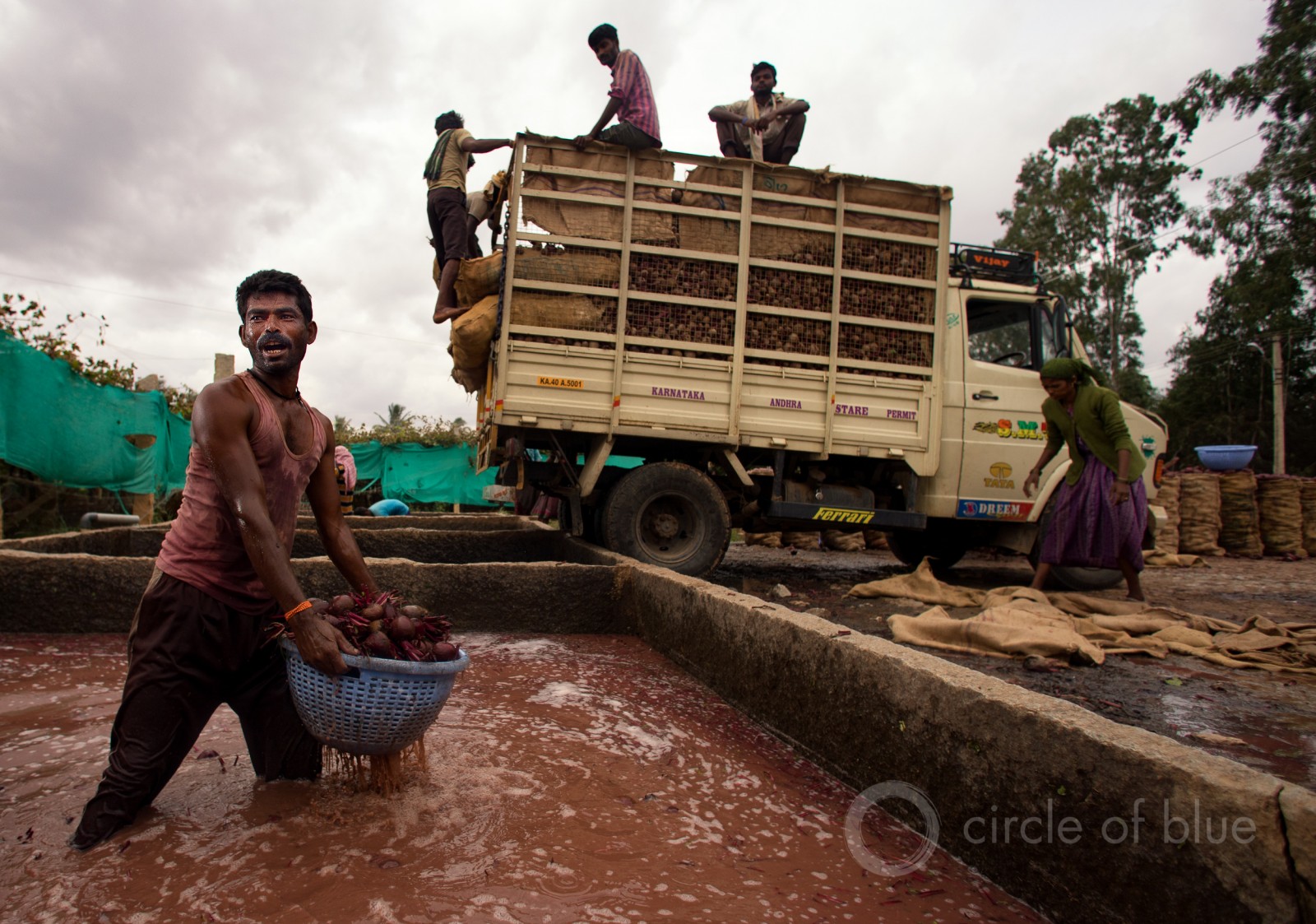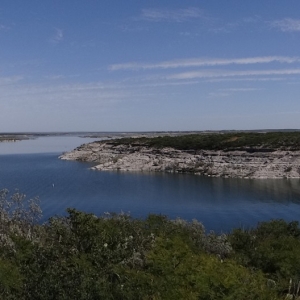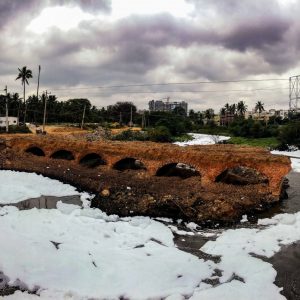The Stream, March 20, 2024: Bengaluru Residents, Facing Water Shortage Crisis, Consider Leaving As Hot Summer Looms

Farmers stop near Vijayapura to wash red beets on the way to the Bengaluru produce markets. In many cases when wells run dry, farmers irrigate their vegetables with raw sewage. Farmers told Circle of Blue they use washing stations like this to rinse away the smell and that they do not consume their own crops grown in wastewater. Archive photo: J. Carl Ganter / Circle of Blue
YOUR GLOBAL RUNDOWN
- Drought and growing populations have pushed water supplies in Bengaluru, India, whose metro area totals 14 million people, to the brink.
- Millions of people in Zimbabwe are expected to face severe food insecurity as an ongoing drought cripples maize harvests.
- Entering its fourth consecutive year of drought, Calgary again braces for water restrictions and shortages.
- Growers in Vietnam are hoping to save the world’s coffee industry by switching to the climate change-resistant Robusta bean.
Taps in Johannesburg, South Africa are running dry after a pump station power outage, the most recent in what has been a regular occurrence of water shortages.
“The rapid escalation … of the city of Johannesburg’s water woes can be attributed to a dysfunctional and inept municipality, the lack of necessary skilled personnel, as well as the lack of financial resources, or even non-investment into the maintenance of dilapidated infrastructure.” — Anja du Plessis, an associate professor and water expert at the University of South Africa.
As a heat wave smothers Africa’s richest city, a power outage at a pumping station in early March has been the latest mishap in a series of water shortage woes, Voice of Africa reports. For two weeks, half of the city’s water supply area — including several hospitals and many businesses — has faced dry taps and inconsistent access. A longstanding energy crisis, coupled with improper investment and mismanagement, experts say, led to the current situation.
Only half of the money required to operate and maintain Johannesburg’s water infrastructure is allocated in the city’s budget, The Conversation reports. About 15 million people depend on the current system — which, researchers say, is designed with far fewer in mind.
— Christian Thorsberg, Interim Stream Editor
Recent WaterNews from Circle of Blue
- Can U.S and Mexico Secure Water Supplies in Shrinking Rio Grande? — Changes are needed in 80-year-old water treaty to accommodate the drying climate.
- New Report Sparks Questions and Controversy over Possible Causes for Iowa “Cancer Crisis” — Binge drinking doubted as cause of Iowa’s rising cancer incidence.
The Lead
India’s southern state of Karnataka and its capital Bengaluru, whose metropolitan area totals more than 14 million people, is running out of water. This March the region’s 16 major reservoirs are collectively only 29 percent full, with 12 sitting below 10-year average levels of 40 percent capacity, The Hindu reports. Across the country, 150 reservoirs are sitting at 40 percent capacity, their lowest level in five years, Reuters reports.
More than a third of the city’s residents — some 4 million people — rely on a dwindling groundwater supply for their everyday needs, and 6,900 of Bangalore’s 13,900 borewells have run completely dry. Many families have been forced to live in similar conditions as those of Bhavani Mani Muthuvel. The Associated Press reports that Muthuvel and her family of nine ration 25 gallons of water per week for cooking, cleaning, and drinking.
Officials say the El Niño weather phenomenon and climate change are to blame for unreplenished groundwater supplies and a lack of seasonal pre-monsoon rainfall this spring. The city’s growing population has exacerbated demand for the resource, and poor infrastructure — including the fact that 90 percent of Bangalore is covered with paved surfaces, and 70 percent of its green space has been lost in the past half-century — had added to the city’s predicament.
In 2018, the Indian government estimated “ that over 40 percent of Bengaluru residents won’t have access to drinking water by the end of the decade,” AP reports.
In Context: Toxic Water, Toxic Crops: India’s Public Health Time Bomb
Groundwater Scarcity, Pollution Set India on Perilous Course
This Week’s Top Water Stories, Told In Numbers
2.7 million
People in Zimbabwe who will go hungry this year, according to government estimates, as an El Niño-induced drought has caused crops to wither, Reuters reports. Hundreds of thousands of people relied on outside food aid to carry them through recent months, with the demand expected to increase. The maize harvest, one of the nation’s most important crops, is expected to be cut in half this year, with farmers producing just 1.1 million tons amid scarce water conditions.
46
Percent of Calgary’s water resources allocated for crop irrigation, Reuters reports. The western Canadian city is bracing for water limits as it enters its fourth consecutive year of drought, straining its wheat, crude oil, and beef economies. The city has told residents that it may enforce restrictions as early as spring, and water-sharing negotiations between oil and crop production license-holders have opened for the first time in 20 years. Over that span, conservation efforts have helped reduce the city’s per capita water consumption by 30 percent, according to the Calgary Herald.
On the Radar
In Vietnam, the world’s second-largest coffee producer, growers are preparing for the crop’s future in a climate-changing world by pushing an overlooked bean called Robusta, Al Jazeera reports. Unlike other beans produced in places like Brazil, where drought has impacted the coffee economy in recent years, Robusta is more resistant to hot temperatures, disease, and insects. Arabica, the world’s most popular coffee bean variety because of its superior flavor, is expected to see its production cut in half by 2088, due to warm weather and unpredictable precipitation.
More Water News
Chicago Lead: A new report shows that nearly 130,000 children in Chicago are exposed to unsafe levels of lead in their household drinking water, as a result of the city’s lasting lead pipes, the Guardian reports.
Iceland’s Volcano: The fourth eruption in three months of a volcano in southern Iceland has sent lava flows dangerously close — within 700 feet — to the nearby town Grindavik’s main water line and geothermal power plant, RÚV reports.
Christian Thorsberg is an environmental writer from Chicago. He is passionate about climate and cultural phenomena that often appear slow or invisible, and he examines these themes in his journalism, poetry, and fiction.






Leave a Reply
Want to join the discussion?Feel free to contribute!